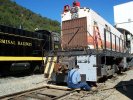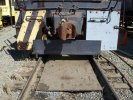|
Southern
Pacific
1218
Metal Work Of All Kinds
At some point, the 1218 was
the victim of a
collision
with a hopper car. I don't know about damage to the hopper
but
the 1218 probably came out second best. The hand rails on the
fireman's side were mangled and the battery box was torn
open.
The hand rails are made of 1 by 3 flat steel and heavy wall
pipe.
We were able to straighten the flat steel but the pipe was beyond
repair so new pipe was purchased. The bent sections were cut
out
of the battery box, straightened and then welded back in. The
final touch was a new battery box door.
One of the spring pads was
missing from the rear of the left front
truck. It
was likely knocked out during a derailment and appeared to have been
missing for a long time. We fabricated a new one and
installed it
with the aid of a 50 ton jack.
The
deck material on the 1218 is a 1/4" thick anti-slip material called
"diamond plate". The plate lays on top of the frame which is
a
solid block of steel, 3 inches thick. Water accumulates
between
the plate and the deck and results in rust which destroys the
plate. There were a few places on the front deck where the
plate
was actually rusted complete through. We elected to replace
it
all. We had to cut what seemed like a thousand feet of weld
and
then needle gun the frame surface to get rid of the rust.
Many of the hand rails
and grab irons were bent and one had to be built new because of the
collision with the hopper car some years ago. We used a
variety
of methods to straighten the rails, including a chain hoist, a
hydraulic pipe bender
suspended from the fork lift and the good old oxyacetylene
torch.
Our blacksmith Joe Mann modified a hand rail salvaged from a scrap Alco
RSD1. It was rather amazing to see the way he rearranged the
bends and made it fit.
The steps on the front end
of the 1218 were in terrible shape. The locomotive had been
derailed any number of times and the front sheet metal suffered from
that abuse. It was necessary to completely remove the stairs
on
both sides, straighten the steel sheets in a hydraulic press and put it
all back together with new bolts and fresh welds. The front
beam
on the left side needed to be straightened with the help of a 50 ton
hydraulic jack held in position by our hydraulic crane. The
left
front piece of 1/2" plate was so mangled that it was replaced.
The lower 4" of sheet metal on the
hood were in dire need of replacement due to rust between it and the
hood frame.
Federal law requires that
there be
an end plate which extends across both rails and that it be no closer
than 3" and no further than 6" from the top of the rail. We
bought 2 pieces of 3/8" plate and attached them in the appropriate
places. The new end sheets will be pretty much covered by the
foot boards when
they are installed.
 |
 |
Foot
boards were
outlawed on diesel locomotives used in switching service after
September 30, 1978. Our experience is that if use
of foot
boards is prohibited, they may be present for historic
purposes.
So, we elected to built a set for the 1218. The brackets are
1"
thick steel, 4" wide, each with a 90 degree bend. Want to try
to
find someone to bend 1" steel plate? One would think that the
greater San Francisco Bay Area would have a company with this capacity
but, no such luck. So, the cheap, do it yourself approach was
used. And in hind sight, it was pretty easy. Each
piece was
secured to our blacksmith table and heated with a rosebud
tip.
When the proper degree of red was reached, a wrench with cheater was
applied to the free end of the steel and a strong pull downward
resulted in a nice clean bend. It is amazing what can be done
with heat and leverage!
More To Come!
|